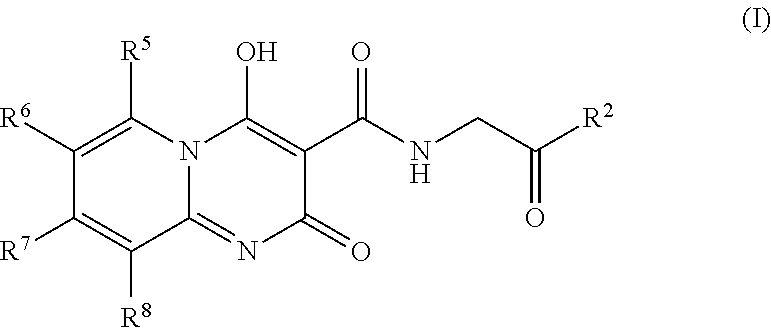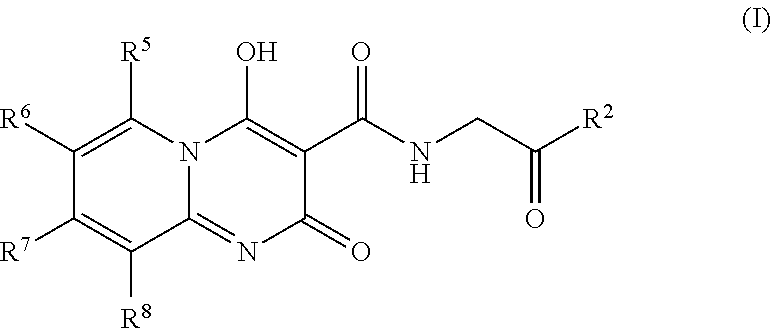Prolyl Hydroxylase Inhibitors
a technology of prolyl hydroxylase and inhibitor, which is applied in the direction of biocide, drug composition, extracellular fluid disorder, etc., can solve the problems of reduced oxygen levels in the blood, ubiquitination of hif-alpha and subsequent degradation, and achieve the effect of increasing the production of erythropoietin and epo
- Summary
- Abstract
- Description
- Claims
- Application Information
AI Technical Summary
Benefits of technology
Problems solved by technology
Method used
Image
Examples
example 1
[0076]
N-[(4-hydroxy-2-oxo-2H-pyrido[1,2-a]pyrimidin-3-yl)carbonyl]glycine
[0077]A mixture of 2-aminopyridine (0.100 g, 1.06 mmol), triethyl methanetricarboxylate (0.490 mL, 2.33 mmol) and toluene (2 mL) was stirred in a microwave reactor at 155° C. for 25 min. After cooling, ether (˜2 mL) was added and the precipitate filtered. A mixture of this precipitate, glycine (0.278 g, 3.71 mmol), 1,8-diazabicyclo[5.4.0]undec-7-ene (0.555 mL, 3.71 mmol) and ethanol (1.5 mL) was stirred in a microwave reactor at 160° C. for 25 min. After cooling, the mixture was diluted with water (5 mL), washed with ethyl acetate, acidified to pH 3-4 with 6 M aqueous hydrochloric acid and extracted with ethyl acetate. The extracts were washed with brine, then evaporated under reduced pressure. The residue was purified by preparative rp-HPLC (ODS, 10-90% acetonitrile / water+0.1% trifluoroacetic acid) to give the title compound (0.032 g, 11%) as a white powder. 1H NMR (400 MHz, DMSO-d6) δ ppm 4.13 (d, J=5.56 Hz, ...
example 2
[0078]
[0079]2a) N-({4-hydroxy-9-[(1-methylethyl)oxy]-2-oxo-2H-pyrido[1,2-a]pyrimidin-3-yl}carbonyl)glycine
[0080]Ethyl 4-hydroxy-9-[(1-methylethyl)oxy]-2-oxo-2H-pyrido[1,2-a]pyrimidine-3-carboxylate. A solution of 3-[(1-methylethyl)oxy]-2-pyridinamine (0.100 g, 0.657 mmol) and triethyl methanetricarboxylate (0.305 g, 1.31 mmol) in 1,2-dichlorobenzene (1 mL) was heated in a microwave reactor at 200° C. for 20 min, then cooled and chromatographed (silica gel, 1-9% methanol / dichloromethane) to give the title compound (0.118 g, 61%) as a gum, containing two tautomers. Major tautomer (˜87%): 1H NMR (400 MHz, DMSO-d6) δ ppm 1.25 (t, J=7.07 Hz, 3 H) 1.36 (d, J=5.81 Hz, 6 H) 4.18 (q, J=7.07 Hz, 2 H) 4.86 (sept, J=6.06 Hz, 1 H) 7.29 (t, J=7.45 Hz, 1 H) 7.71 (d, J=7.83 Hz, 1 H) 8.52 (dd, J=6.95, 1.14 Hz, 1 H) 11.98 (br. s., 1 H). Minor tautomer (˜13%): 1H NMR (400 MHz, DMSO-d6) δ ppm 1.21 (t, J=7.07 Hz, 3 H) 1.27 (d, J=5.81 Hz, 6 H) 4.06 (q, J=7.07 Hz, 1 H) 4.63 (sept, J=6.08 Hz, 1 H) 7.15 (dd...
example 3
[0083]
[0084]3a) N-[(7-bromo-4-hydroxy-2-oxo-2H-pyrido[1,2-a]pyrimidin-3-yl)carbonyl]glycine
[0085]N-(3-[(1,1-Dimethylethyl)oxy]-2-{[(1,1-dimethylethyl)oxy]carbonyl}-3-oxopropanoyl)glycine. Sodium hydride (0.407 g of a 60% oil suspension, 10.2 mmol) was added to an ice-cooled, stirred solution of di-tert-butyl malonate (2.00 g, 9.25 mmol) in THF (30 mL) under nitrogen. The mixture was warmed to room temperature and stirred 15 min, giving a colourless solution. Ethyl isocyanatoacetate (1.14 mL, 10.2 mmol) was injected into the mixture and the that mixture stirred for 5 min at room temperature and 1 h under reflux, then cooled and poured into ice-cold / 0.1 M aqueous hydrochloric acid (130 mL). The mixture was extracted with ethyl acetate and the extracts washed with water, brine, then dried (MgSO4) and the solvent evaporated under reduced pressure. The residue was chromatographed (silica gel, 0-9% methanol / dichloromethane) to give the intermediate ester (1.54 g). 1 M aqueous sodium hydro...
PUM
| Property | Measurement | Unit |
|---|---|---|
| weight | aaaaa | aaaaa |
| weight | aaaaa | aaaaa |
| weight | aaaaa | aaaaa |
Abstract
Description
Claims
Application Information
 Login to View More
Login to View More - R&D
- Intellectual Property
- Life Sciences
- Materials
- Tech Scout
- Unparalleled Data Quality
- Higher Quality Content
- 60% Fewer Hallucinations
Browse by: Latest US Patents, China's latest patents, Technical Efficacy Thesaurus, Application Domain, Technology Topic, Popular Technical Reports.
© 2025 PatSnap. All rights reserved.Legal|Privacy policy|Modern Slavery Act Transparency Statement|Sitemap|About US| Contact US: help@patsnap.com



